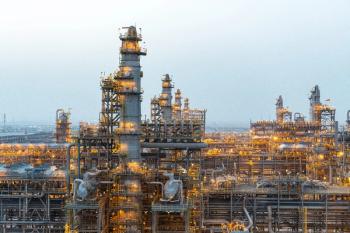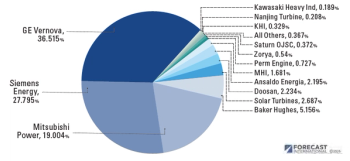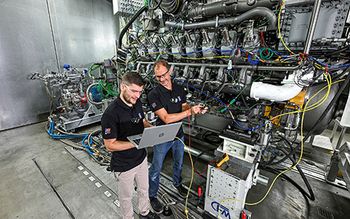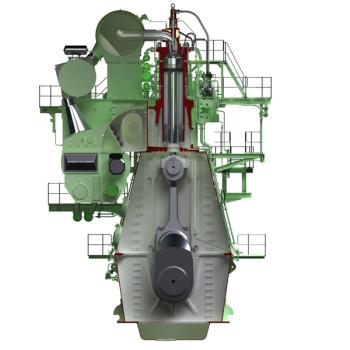
- January/February 2022
Show Report: TPS 2022
The fiftieth annual Turbomachinery Symposium took place in mid-December 2021 in Houston. Texas. Attendees were delighted to be face to face with their peers once again. For most, it had been two years since their last industry show. Just about everyone commented that being at a live show highlighted how unsatisfactory virtual events were in comparison. Clearly, live events are a needed and wanted commodity in the industry.
As expected, attendance at the show was a little down. With oversees visitors at a minimum due to various travel restrictions, and some companies within the U.S. forbidding travel, that was to be expected. Despite that, the event attendance was only 30% down compared to 2019. The exhibit floor suffered a similar drop. However, most vendors were satisfied by the event. Several said they had about half the booth visitors but got as many leads and inquiries as they experienced two years ago. One person said, “half the visitors, and four times the interest.”
Supercritical CO2
The welcome address by Eric Petersen, Director of the Turbomachinery Laboratory at Texas A&M University, kicked off the show. He updated the audience on what had been happening over the past two years, the activities of the Turbomachinery Lab, the Industrial Advisory Committee for the Symposium, and the programs of the Turbomachinery Research Consortium (TRC). The biggest news is the building of a new wing for the Turbomachinery Lab.
Following the keynote, scores of technical sessions took place over the next three days. Southwest Research Institute (SwRI) delivered a talk on supercritical CO2 power cycles (sCO2). There has been much talk about the transformational nature of this technology for a decade or more. But commercial applications are only just beginning to appear such as those from Hanwha Power Systems.
Supercritical Carbon Dioxide power cycles provide higher thermal efficiency compared to traditional heat-source energy conversion including conventional fossil and alternative energy sources. This reduces capital costs due to smaller equipment footprints and design modularity. In addition, sCO2 allows for rapid cyclic load and source following to balance solar and wind energy power swings.
Compressing CO2 is not new. But it has been accomplished mostly at lower vapor pressures or at higher pressure and lower temperatures as a liquid. Compression near the dome (near critical pressure and temperature – approximately 95°F and 1,233 psi) has the advantage of a low head requirement. To then pressurize from 1,233 psi (the target inlet pressure of power cycles) to 3,916 psi, only a single compressor stage is required. With far less power needed for compression, thermal efficiency is increased.
Stephan Cich, Group Leader in SwRI’s Machinery Section, listed some of the favorable fluid properties of sCO2 such as low specific heat, high density, and high thermal conductivity. That can mean only having to build a single-stage, high-speed compressor rather than multi-stage low-speed machines.
But there are challenges. Around the transition phase of sCO2between liquid and supercritical fluid, for example, there are massive swings in density and enthalpy. There are also mechanical instabilities, flow challenges, and potential for chocking.
“A high gas mean density and higher speed leads to high potential for mechanical instabilities,” said Cich. “There is also a need to find the right balance between aerodynamics and rotordynamics in sCO2 compressor design as these two areas tend to be in conflict.”
Oil & Gas Compressors
An Elliott Group session gave an overview of the various types of compressors and air blowers used in the oil and gas industry. Brian Pettinato, Manager of Aero and Structural Dynamics at Elliott, briefly covered the basics, applications, and operation of compressors, expanders, steam, and gas turbines in refineries.
Modern refineries utilize a wide range of turbomachinery that must flexibly operate under harsh fluid conditions with long life and minimal maintenance downtime. In refinery service, the fluids pose unique aerodynamic, materials, and structural design challenges including wet gas service, high gas path temperatures, and corrosive, flammable, and sometimes toxic service. These requirements make the design, packaging, controls, application, and operation of turbomachines in refineries both complex and challenging. Operational and technical details or turbine and compression applications such as gas boost, refrigeration, hydrogen recycle, blow gas compression, coke gas compression, reformer recycle compression, steam turbine drivers, and gas turbine drives were discussed including alkylation, reforming, hydrocracking, fluid cracking, power generation, and gas boost.
There followed a discussion of the materials used in compressors delivered by Derrick Bauer of Elliott Group. He said impellers typically use low alloy steel (4140/4340) and martensitic stainless steel as they are highly stressed components that require materials with high yield strength. Austenitic steels are not strong enough.
“Material selection should consider the right materials to eliminate the risk of stress corrosion cracking (SCC),” said Bauer.
The compressor shaft, on the other hand, is typically made from low-allow steel. Stainless steel is generally only needed in shafts if highly corrosive process gas is present. Shafts are not normally at risk of SCC. It is the couplings that are under high stress, not the shaft. Internal stationary components are usually made from structural-grade carbon steel and casings from carbon steel. With heat treatment, pressure-vessel carbon steel can tolerate temperatures as low as -50°F. Bauer said increased nickel content allows for lower temperatures, and cladding can be utilized to address corrosion issues.
Another Elliott session covered turbomachinery for olefins. Also known as alkenes, olefins is a term generally denoting hydrocarbons that contain at least one double bond. Because of their high reactivity, availability, and low cost, they are used primarily in petrochemical synthesis, plastics, synthetic rubber, and chemical fibers.The talkoutlined the various compressors, expanders, and steam turbines used in the plastics industry.
Plastic manufacturing processes such as ethylene plants use a wide range of turbomachinery that must flexibly operate under harsh fluid conditions with long-life and minimal maintenance downtime. Cracked gas feed-gas, propylene, and ethylene refrigeration compressor trains are nearly always custom engineered to meet the high-volume, high-efficiency requirements of modern ethylene plants. In ethylene services, the fluids pose aerodynamic, materials and structural challenges related to wet gas service, fouling, and their high gas path temperatures.
Elliott has developed a process centrifugal compressor capable of dealing with very high flow. The use of increasingly higher flow coefficient stages in centrifugal compression services such as LNG and olefin applications has been a trend since the 1990s.
“For process centrifugal compressor applications, achieving higher flow rates through a given sized compressor can reduce capital cost,” said Vishal Jariwala, Aerodynamics Engineer, Elliott Group. “Key technologies for enabling such higher flow rates are high flow coefficient (design ϕ > 0.12) and very high flow coefficient (design ϕ > 0.20) aerodynamic staging featuring covered impellers.”
Applications involving very high flow (VHF) coefficient staging have only first been applied since around 2010. Elliott has been working on a family of very high flow (VHF) stages with nominal design flow coefficient of 0.24 and moderate to high Machine Mach Number (Mu) of 0.88. The stage aerodynamic performance (range and efficiency) is optimized while still meeting targets related to mechanical robustness and rotor dynamic usability.
“A protype VHF state impeller has a covered mixed flow discharge with seven full and seven splitter blades,” said Jariwala.
Various impeller adjustments have been made to optimize the design. On the stationary component side, for example, small changes were made such as a mixed flow diffuser, a diffusion controller crossover passage, and a low vane-count return channel. Such changes have resulted in the VHF stage’s higher efficiency over the entire range.
In the real world these design adjustments have resulted in cutting thousands of pounds of weight from Elliott’s large 110 M compressor. Two shop orders have been completed and shipped with the VHF stage families. As well as a weight reduction of 23-24%, the benefits include increased flow capacity of 32% and favorable performance characteristics due to aerodynamics changes. Its tested performance compares well with its predicted performance.
John Crane Products
John Crane attended the event to showcase a wealth of new products.
John Crane Sense Turbo is a dry gas seal digital diagnostics solution to monitor conditions at the heart of the compressor without negatively impacting seal performance or life. Sensors embedded directly into a compressor's dry gas seal deliver continuous, real-time insight to identify issues and ensure corrective actions are taken to extend the useful life of the seal. It is part of the John Crane Sense platform ecosystem. Throughout 2022, John Crane will launch two additional digital monitoring solutions focused on wet seals and monitoring other plant equipment.
The High Flow Liquid/Gas Coalescer (HFC) is targeted for refinery, petrochemical and chemical plant applications. It removes aerosols and solids from process and fuel gas streams. Typical process applications include burner tip protection in furnaces, molecular sieve drier bed protection, and amine unit protection. Product benefits include:
Very high separation efficiency of 99.9% for improved process uptime.
Extended filter element lifetime (>12 months) to reduce operating costs.
Increased gas handling capacity (210 am3/hr) per element and welded pressure vessel design results in lower capital costs.
Computational fluid dynamic (CFD) designed for optimum dimensions of the elements and flow distribution.
In the first quarter of 2022, John Crane is launching a couple of new products. The Type 2874HTC incorporates HTC (high-temperature, corrosion-resistant) seal faces and edge-welded metal bellows to provide superior stability and reliable operation at temperatures up to 425°C (800°F). Its outward pumping spiral groove technology results in a dry gas seal that can run at all operating ranges. In corrosive refinery applications, this reduces life-cycle costs compared to conventional wet seals and systems and eliminates problems associated with coking barrier fluids and fouled heat exchangers.
The Type 8648VRS Dual-pressurized Sealwith NPSS seal technology is an expansion of a product that has flourished in the midstream pipeline segment. A new dual-pressurized option for high-pressure pipeline applications ensures full containment of liquids. Its pressurized arrangement isolates the sealing interface from the process liquid, which can vary in composition, volatility and can be subjected to extreme ambient conditions. The Type 8648VRS allows operators to meet containment and safety guidelines while maintaining asset utilization across their network.
The Type 93LR Separation Seal is a non-contacting segmented bushing with a balanced lift-off design that minimizes the gas consumption in both pressure and flow control. The Type 93LR has been designed to meet the requirements of the API 692 standard and reduce the consumption of separation gas. It can be retrofitted to installed dry gas seals in the John Crane product range with minimum modifications. Applications include centrifugal compressors and other rotating equipment in the oil and gas and petrochemical industries. Benefits include:
Balanced lift-off carbon ring minimizes the gas consumption in both pressure control and flow control
Self-centralizing grooves ensure dynamic seal concentricity to the shaft/sleeve
Static restriction to oil ingress when separation gas fails
Consumption independent of the temperature change
No restriction to the gas type or its dew point
Other new John Crane products include:
The FCF Seal Gas Filtration System removes liquid and particle contamination and maximizes reliable dry gas seal operation. The filters comply with international pressure vessel and design codes and were designed in alignment with API 614 and designed for API 692. The new FCF Series, designed with a combination of new flow conditioning technologies, delivers up to 50% lower pressure drop at start-up and in operation.
The GS 54 Global Standardized Plan 54 uses best-practice design to provide clean, cooled and filtered barrier fluid, optimal seal performance and pump up-time. The GS 54 is a standard solution that significantly reduces specification review and delivery schedules and delivers pressurized barrier system control for optimal mechanical seal performance and reliability.
John Crane Diamondtreated silicon carbide offers various performance benefits. Seal face treatments are available as an enhancement to many John Crane seal families. It uses one of the Earth's hardest materials to improve mechanical seal reliability and performance in difficult applications involving poor lubricating fluids, abrasive particulates or slurries, and upset operational conditions such as intermittent dry running. John Crane Diamond's extreme wear resistance enables treated seals to handle abrasive or erosive conditions beyond conventional hard seal face materials. In addition, John Crane Diamond has a low coefficient of friction which results in lower heat generation and energy consumption on the motor.
The next Turbomachinery Symposium will return to its usual time slow. It will be held from September 13 to 15, 2022 in Houston. For more information, visit https://tps.tamu.edu/
Articles in this issue
over 3 years ago
The Digital Twin Knows it Allover 3 years ago
SELECTION, PURCHASE,AND OPERATION OF TURBOMACHINERYover 3 years ago
SENSORS FOR SPEED MEASUREMENTSover 3 years ago
MAN ES emphasizes digital tools and decarbonizationover 3 years ago
Sulzer Services expands offeringsover 3 years ago
Hydrogen Compressionover 3 years ago
CHP upgradesNewsletter
Power your knowledge with the latest in turbine technology, engineering advances, and energy solutions—subscribe to Turbomachinery International today.





